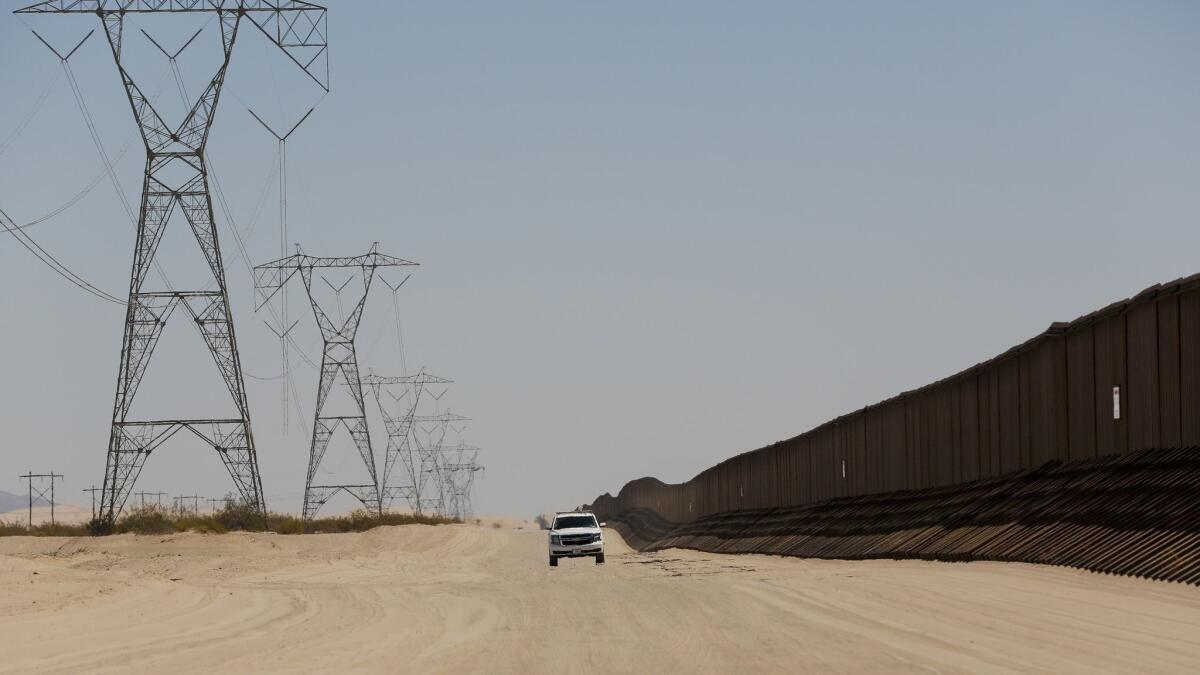Border Patrol launches Operation Blazing Sands to stop human smuggling in California desert

Reporting from El Centro, Calif. — Just east of the border fence construction, the Border Patrol has launched Operation Blazing Sands to deter illegal border crossings and thwart human smuggling attempts.
The agency noticed an uptick in smuggling activity along a stretch of the border in the southeasternmost part of the California desert, according to Agent Justin Castrejon.
Agents apprehended 2,427 people illegally crossing that part of the border from October 2017 through July 2018, according to official data. That’s about eight people per day and more than 10% of the 23,452 people caught in the entire El Centro Sector during the same period.
The sector splits its 70 miles of border among three Border Patrol stations. The 20-mile area where Operation Blazing Sands is focused is patrolled by agents from the Calexico station, which is the fifth busiest along the southwest border, Castrejon said.
About 10 miles outside of the town of Calexico, the landscape turns from farmland to short brush and small mounds of sand. The All-American Canal runs between Interstate 8 and the border, and the canal’s steep sides and strong currents sometimes trap border crossers.
The goal for many trying to sneak across in the El Centro Sector is Interstate 8, Castrejon said. If the migrants can make it to the car that’s supposed to pick them up, they can disappear into traffic.
Near the Gordon Wells exit on Interstate 8, the All-American Canal curves under the highway, removing one obstacle from border crossers’ path and allowing the freeway to stretch closer to Mexico. The sand begins to mound higher in this part of the desert.
A Border Patrol camera tower stands near the exit, and agents frequently make “cuts” in the area, checking for footprints where they had dragged the sand smooth earlier.
Just before the canal turns away from Mexico, the border fence changes from 15- to 20-foot bollards used in town to a “floating fence” that was built about 2009. The floating fence has similar bollards, or posts placed close together, but they are a few feet shorter, and the base allows agents to prevent sand from mounding along the fence — which would make it easier to climb over. If the sand gets too high, the fence can be lifted and set down again on top.

Border Patrol launches Operation Blazing Sands in California desert
Despite the heat and the sand, the area around Gordon Wells has become a popular place to cross, Castrejon said.
He and fellow Agent Jose Enriquez pointed out footprints on the Mexican side of the fence and a piece of rope tied between bollards that would act as a ladder. Sun-bleached water bottles were scattered on the ground.
Castrejon said that when he was patrolling the Gordon Wells area about a month ago, an agent monitoring the camera tower alerted him to a group that had just crossed — fewer than 10 minutes after he had last checked there.
“As much as we’re watching out for them, they’re watching us,” he said.
The group made it to a car and headed west on the freeway. Castrejon responded, arresting one U.S. citizen on suspicion of smuggling and four border crossers.
When border crossers do make it to the highway, agents can try to pull the car over. If the driver refuses to stop, agents collaborate over radios to monitor where the car goes. In some cases, agents will use a spike strip to stop the vehicle, Castrejon said.
After agents make arrests, they backtrack to the border to look for people the group might have left behind. Smugglers often abandon anyone sick or injured because they don’t want to slow down the group, Castrejon said.
“Smugglers don’t have any regard for human life,” he said. “All they care about is money.”
Operation Blazing Sands, a collaboration launched in mid-August between the El Centro Sector and the Yuma, Ariz. Sector, has increased the number of agents operating in the area, borrowing from stations in both sectors, Castrejon said. He was not permitted to say how many agents were involved.
The operation’s first arrest came two days after the effort began, according to a Border Patrol statement, when an agent spotted five people crossing illegally into the U.S. The group got into a car, and the agent followed and stopped it in Brawley.
Castrejon declined to say how many people the operation has apprehended, but according to agency statements that cited Blazing Sands, at least 10 people, almost all U.S. citizens, have been charged with human smuggling under the operation. They were transporting 23 would-be migrants.
The operation is also intended to prevent migrants from dying in the desert’s extreme heat. Temperatures there can reach 120 during summer.
Border Patrol agents in the El Centro Sector have found the bodies of 14 people who died crossing the border so far in fiscal 2018, Castrejon said.
“A lot of times, people will get in trouble and underestimate their abilities,” he said, adding that agents treat many who cross in this area for heat exhaustion. “The terrain is unforgiving.”
Castrejon declined to say how long the operation would last because the Border Patrol doesn’t want to tip off smugglers.
“It’s going to be in operation for the foreseeable future,” he said.
The agency also plans to gather intelligence on smuggling organizations in the area as part of the project.
Morrissey writes for the San Diego Union-Tribune.
More to Read
Sign up for Essential California
The most important California stories and recommendations in your inbox every morning.
You may occasionally receive promotional content from the Los Angeles Times.










